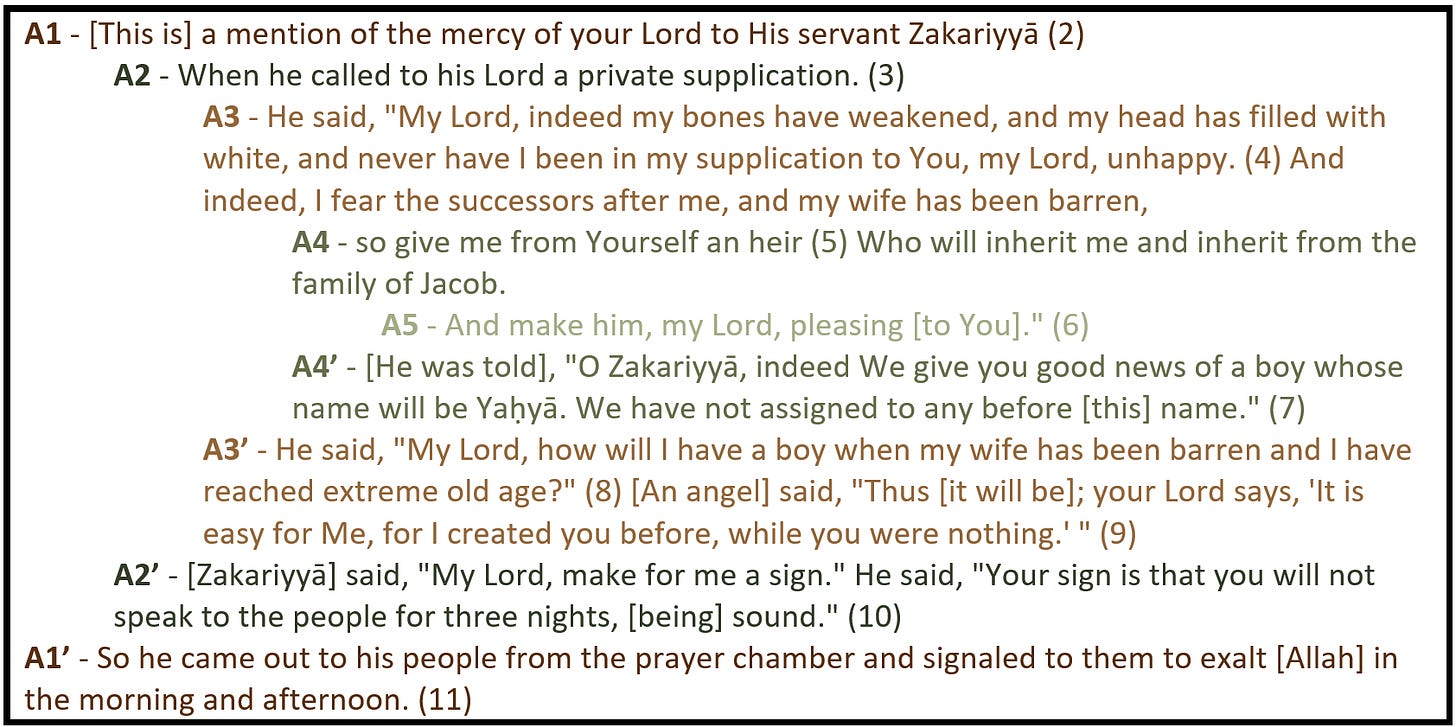Sūrah Maryam (Part 1)
Part 1 of observations on the structuring, organization, and cohesion of Sūrah Maryam
Alḥamdulillāh (All praise and thanks belong to Allah), our teacher, Shaykh Furhan Zubairi, has recently published an English tafsīr (scholary explanation) of Sūrah Maryam (Mary, mother of Jesus) and the appendix of the book features an in-depth structural analysis of the entire sūrah authored by us! Heavenly Order is officially published!
If you have benefitted at all from this blog over the past year, please consider supporting our teacher and Islamic seminary through the purchase of this book.1 It is ideal for anyone looking to engage the words of Allah ﷻ without fear of blaspheming or interpreting His words in the wrong way.
For those who choose not to, know that we will publish the entire appendix here, in parts, over the coming weeks.2 This is the most detailed we’ve ever gone into a sūrah, so expect this series to delve into every aspect of the sūrah’s coherence (as far as we could observe).
Big Picture
Because of the length and complexity of Sūrah Maryam, we will begin with a macroscopic view of the contents and then slowly work our way down to the microscopic level.
Overall, the sūrah appears to be organized in a ring composition as shown below, with āyah numbers given in parenthesis:
Note the omission of the first āyah. We will come back to it towards the conclusion of the sūrah’s analysis.
As for the overall structure, we will return to the connection between each of these Sections once we’ve analyzed them in detail over the coming weeks.
Section [A] - Divine Intervention at Birth
The beginning section of Sūrah Maryam focuses on the stories of Zakariyyā (Zechariah) and Maryam. When observed more closely, it appears that the Section can be split into four smaller parts, each focusing on a different narrative.
The first half of Section [A] contains two rings. The first ring is about Zakariyyā and the second ring is about Yaḥyā (John). The ring corresponding to Zakariyyā looks as so:
Connections
[A1/A1’] - Allah’s mentioning (dhikr) of His servant, Zakariyyā, is paired with the mentioning and praising of Allah ﷻ (sabbiḥū) by His servants.
[A2/A2’] - Zakariyyā begins the Sūrah calling to Allah ﷻ quietly so that no one else would hear, and ends the Section being only able to speak to Allah ﷻ with no one else capable of hearing him, even if he desired so.
[A3/A3’] - At first Zakariyyā explains that his old age and barren ('āqirā) wife’s condition mean that they cannot have children through their own means, and then he repeats these traits, old and barren ('āqirā), after being shocked with the good news of a son.
[A4/A4’] - Zakariyyā prays for an heir that will inherit from him and is then given the good news of one. Interestingly, Zakariyyā is told that his son will have a unique name, i.e., one that he inherited from no one before him.
[A5] - This section can be argued to center on the trait of being pleasing to Allah ﷻ (raḍiyā). As we will see in the forthcoming sections, the motif of having a good family runs throughout this sūrah, which will continue to highlight the importance of praying for righteous children who are pleasing to Allah ﷻ.
The ring for Yaḥyā appears to be structured as follows:
Connections
[A6/A6’] - The ring begins by informing us of Yaḥyā when he was still a child; i.e., the beginning of life. The corresponding āyah grants us the remaining details of his life span as it tells us how he will die and be resurrected. His entire life was thus summarized in these paired āyāt.
[A7/A7’] - Both parts give two praiseworthy attributes of Yaḥyā.3
[A8] - The fifth description of Yaḥyā, which sits in the middle of the entire ring, is Yaḥyā’s quality of being conscious of Allah ﷻ (taqiyyā). Connecting back to the ring that focused on Zakariyyā, it may be that the hallmark of a child that is pleasing to Allah ﷻ (raḍiyyā) is one who is always conscious of Allah ﷻ (taqiyyā).
The second half of Section [A] teaches us about Maryam and her child, ʿĪsā (Jesus). This half can also be split into two parts, with each part forming its own parallel structure. We will continue from here in next week’s post, in shā' Allah (God willing).
والله أعلم - And Allah knows best
Please remember to support our institute and teachers by purchasing this book. If you get it, you can have the entire structural breakdown of Sūrah Maryam in one place!
We do not financially benefit from your purchase of the book. All proceeds go to our teacher and seminary. BUT, if you’d like to support our work specifically, you can join our paid subscriber list by clicking below!
What we publish here will actually be a little more refined as we find things to improve upon through our revisiting of the research.
We thought about splitting this up further and pairing “affection” with not being a “disobedient tyrant” and pairing “purity” with “dutiful to parents,” but these connections seem to be more in the realm of what a scholar may conclude through tafsīr research, as opposed to a clear connection we can make through structure. In other words, there was nothing concrete linking them besides, “they are across from each other in the ring.” Thus we left them as is.






